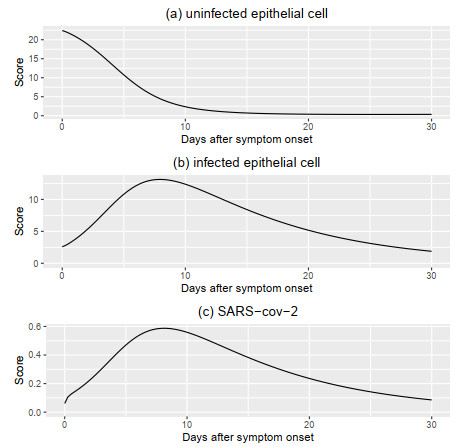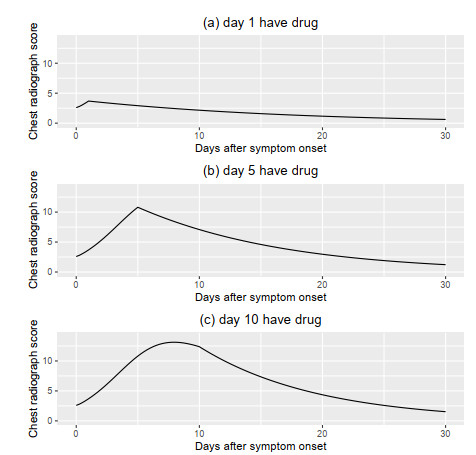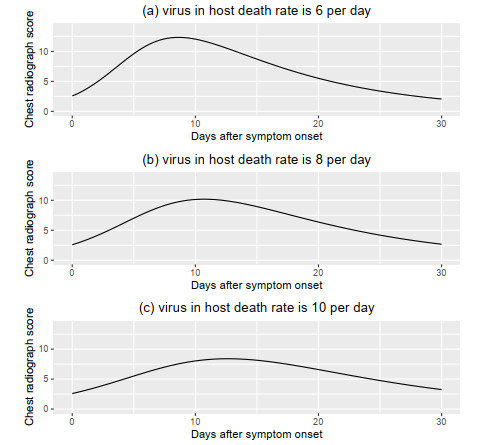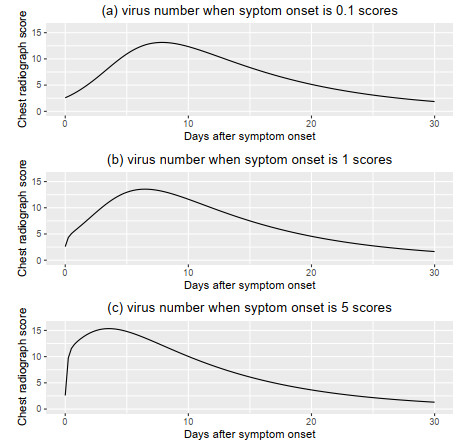| 1.
|
Alexis Erich S. Almocera, Griselda Quiroz, Esteban A. Hernandez-Vargas,
Stability analysis in COVID-19 within-host model with immune response,
2021,
95,
10075704,
105584,
10.1016/j.cnsns.2020.105584
|
|
| 2.
|
Charlotte Kern, Verena Schöning, Carlos Chaccour, Felix Hammann,
Modeling of SARS-CoV-2 Treatment Effects for Informed Drug Repurposing,
2021,
12,
1663-9812,
10.3389/fphar.2021.625678
|
|
| 3.
|
Woochang Hwang, Winnie Lei, Nicholas M Katritsis, Méabh MacMahon, Kathryn Chapman, Namshik Han,
Current and prospective computational approaches and challenges for developing COVID-19 vaccines,
2021,
172,
0169409X,
249,
10.1016/j.addr.2021.02.004
|
|
| 4.
|
Chunxiang Ma, Hu Zhang,
COVID-19, a far cry from the influenza,
2020,
3,
2096-5303,
100,
10.1093/pcmedi/pbaa015
|
|
| 5.
|
Bhagya Jyoti Nath, Kaushik Dehingia, Vishnu Narayan Mishra, Yu-Ming Chu, Hemanta Kumar Sarmah,
Mathematical analysis of a within-host model of SARS-CoV-2,
2021,
2021,
1687-1847,
10.1186/s13662-021-03276-1
|
|
| 6.
|
Yamin Ding, Yuxuan Fu, Yanmei Kang,
Stochastic analysis of COVID-19 by a SEIR model with Lévy noise,
2021,
31,
1054-1500,
043132,
10.1063/5.0021108
|
|
| 7.
|
Ihtisham Ul Haq, Mehmet Yavuz, Nigar Ali, Ali Akgül,
A SARS-CoV-2 Fractional-Order Mathematical Model via the Modified Euler Method,
2022,
27,
2297-8747,
82,
10.3390/mca27050082
|
|
| 8.
|
A. M. Elaiw, A. D. Al Agha, M. A. Alshaikh,
Global stability of a within-host SARS-CoV-2/cancer model with immunity and diffusion,
2022,
15,
1793-5245,
10.1142/S1793524521500935
|
|
| 9.
|
Eugenia Ch. Yiannakopoulou,
2023,
9780323917940,
291,
10.1016/B978-0-323-91794-0.00012-3
|
|
| 10.
|
Kaushik Dehingia, Ahmed A. Mohsen, Sana Abdulkream Alharbi, Reima Daher Alsemiry, Shahram Rezapour,
Dynamical Behavior of a Fractional Order Model for Within-Host SARS-CoV-2,
2022,
10,
2227-7390,
2344,
10.3390/math10132344
|
|
| 11.
|
A. M. Elaiw, A. S. Shflot, A. D. Hobiny,
Stability analysis of SARS-CoV-2/HTLV-I coinfection dynamics model,
2022,
8,
2473-6988,
6136,
10.3934/math.2023310
|
|
| 12.
|
Ahmed M. Elaiw, Afnan D. Al Agha,
Analysis of the In-Host Dynamics of Tuberculosis and SARS-CoV-2 Coinfection,
2023,
11,
2227-7390,
1104,
10.3390/math11051104
|
|
| 13.
|
Ahmed. M. Elaiw, Abdullah J. Alsaedi, Aatef. D. Hobiny, Shaban. A. Aly,
Global Properties of a Diffusive SARS-CoV-2 Infection Model with Antibody and Cytotoxic T-Lymphocyte Immune Responses,
2022,
11,
2227-7390,
190,
10.3390/math11010190
|
|
| 14.
|
Ahmed M. Elaiw, Abdullah J. Alsaedi, Afnan Diyab Al Agha, Aatef D. Hobiny,
Global Stability of a Humoral Immunity COVID-19 Model with Logistic Growth and Delays,
2022,
10,
2227-7390,
1857,
10.3390/math10111857
|
|
| 15.
|
Lisette dePillis, Rebecca Caffrey, Ge Chen, Mark D. Dela, Leif Eldevik, Joseph McConnell, Shahrokh Shabahang, Stephen A. Varvel,
A mathematical model of the within-host kinetics of SARS-CoV-2 neutralizing antibodies following COVID-19 vaccination,
2023,
556,
00225193,
111280,
10.1016/j.jtbi.2022.111280
|
|
| 16.
|
Indrajit Ghosh,
Within Host Dynamics of SARS-CoV-2 in Humans: Modeling Immune Responses and Antiviral Treatments,
2021,
2,
2662-995X,
10.1007/s42979-021-00919-8
|
|
| 17.
|
Ahmed M. Elaiw, Raghad S. Alsulami, Aatef D. Hobiny,
Modeling and Stability Analysis of Within-Host IAV/SARS-CoV-2 Coinfection with Antibody Immunity,
2022,
10,
2227-7390,
4382,
10.3390/math10224382
|
|
| 18.
|
A.M. Elaiw, A.D. Al Agha,
Global dynamics of SARS-CoV-2/cancer model with immune responses,
2021,
408,
00963003,
126364,
10.1016/j.amc.2021.126364
|
|
| 19.
|
Verena Schöning, Charlotte Kern, Carlos Chaccour, Felix Hammann,
Effectiveness of Antiviral Therapy in Highly-Transmissible Variants of SARS-CoV-2: A Modeling and Simulation Study,
2022,
13,
1663-9812,
10.3389/fphar.2022.816429
|
|
| 20.
|
Dmitry Grebennikov, Ekaterina Kholodareva, Igor Sazonov, Antonina Karsonova, Andreas Meyerhans, Gennady Bocharov,
Intracellular Life Cycle Kinetics of SARS-CoV-2 Predicted Using Mathematical Modelling,
2021,
13,
1999-4915,
1735,
10.3390/v13091735
|
|
| 21.
|
A. D. Al Agha, A. M. Elaiw,
Global dynamics of SARS-CoV-2/malaria model with antibody immune response,
2022,
19,
1551-0018,
8380,
10.3934/mbe.2022390
|
|
| 22.
|
Ahmed M. Elaiw, Raghad S. Alsulami, Aatef D. Hobiny,
Dynamic Behaviors of a COVID-19 and Influenza Co-Infection Model with Time Delays and Humoral Immunity,
2023,
12,
2075-1680,
151,
10.3390/axioms12020151
|
|
| 23.
|
Saswati Pal, Nabiul Islam, Sudip Misra,
VIVID: In Vivo End-to-End Molecular Communication Model for COVID-19,
2021,
7,
2372-2061,
142,
10.1109/TMBMC.2021.3071767
|
|
| 24.
|
Ahmed M. Elaiw, Abdulsalam S. Shflot, Aatef D. Hobiny,
Global Stability of Delayed SARS-CoV-2 and HTLV-I Coinfection Models within a Host,
2022,
10,
2227-7390,
4756,
10.3390/math10244756
|
|
| 25.
|
Behzad Ghanbari,
On fractional approaches to the dynamics of a SARS-CoV-2 infection model including singular and non-singular kernels,
2021,
28,
22113797,
104600,
10.1016/j.rinp.2021.104600
|
|
| 26.
|
Afnan D. Al Agha, Ahmed M. Elaiw, Shaimaa A. Azoz, Esraa Ramadan,
Stability analysis of within‐host SARS‐CoV‐2/HIV coinfection model,
2022,
45,
0170-4214,
11403,
10.1002/mma.8457
|
|
| 27.
|
Ahmed M. Elaiw, Abdulsalam S. Shflot, Aatef D. Hobiny, Shaban A. Aly,
Global Dynamics of an HTLV-I and SARS-CoV-2 Co-Infection Model with Diffusion,
2023,
11,
2227-7390,
688,
10.3390/math11030688
|
|
| 28.
|
S. M. E. K. Chowdhury, J. T. Chowdhury, Shams Forruque Ahmed, Praveen Agarwal, Irfan Anjum Badruddin, Sarfaraz Kamangar,
Mathematical modelling of COVID-19 disease dynamics: Interaction between immune system and SARS-CoV-2 within host,
2022,
7,
2473-6988,
2618,
10.3934/math.2022147
|
|
| 29.
|
Andrew Omame, Mujahid Abbas,
Modeling SARS-CoV-2 and HBV co-dynamics with optimal control,
2023,
615,
03784371,
128607,
10.1016/j.physa.2023.128607
|
|
| 30.
|
Ahmed M. Elaiw, Afnan D. Al Agha,
Global Stability of a Reaction–Diffusion Malaria/COVID-19 Coinfection Dynamics Model,
2022,
10,
2227-7390,
4390,
10.3390/math10224390
|
|
| 31.
|
A.M. Elaiw, A.J. Alsaedi, A.D. Hobiny, S. Aly,
Stability of a delayed SARS-CoV-2 reactivation model with logistic growth and adaptive immune response,
2023,
616,
03784371,
128604,
10.1016/j.physa.2023.128604
|
|
| 32.
|
Afnan Al Agha, Safiya Alshehaiween, Ahmed Elaiw, Matuka Alshaikh,
A Global Analysis of Delayed SARS-CoV-2/Cancer Model with Immune Response,
2021,
9,
2227-7390,
1283,
10.3390/math9111283
|
|
| 33.
|
S. A. Azoz, A. M. Elaiw, E. Ramadan, A. D. Al Agha, Aeshah A. Raezah, Chang Phang,
Global Dynamics of a Within-Host COVID-19/AIDS Coinfection Model with Distributed Delays,
2022,
2022,
2314-4785,
1,
10.1155/2022/9129187
|
|
| 34.
|
A.M. Elaiw, A.J. Alsaedi, A.D. Hobiny,
Global stability of a delayed SARS-CoV-2 reactivation model with logistic growth, antibody immunity and general incidence rate,
2022,
61,
11100168,
12475,
10.1016/j.aej.2022.05.034
|
|
| 35.
|
A. M. Elaiw, A. D. Al Agha, S. A. Azoz, E. Ramadan,
Global analysis of within-host SARS-CoV-2/HIV coinfection model with latency,
2022,
137,
2190-5444,
10.1140/epjp/s13360-022-02387-2
|
|
| 36.
|
Tuersunjiang Keyoumu, Ke Guo, Wanbiao Ma,
Periodic oscillation for a class of in-host MERS-CoV infection model with CTL immune response,
2022,
19,
1551-0018,
12247,
10.3934/mbe.2022570
|
|
| 37.
|
A. Sa’adah, D. A. Kamil, G. E. Setyowisnu,
2022,
2501,
0094-243X,
020004,
10.1063/5.0091002
|
|
| 38.
|
Antoine Danchin, Oriane Pagani-Azizi, Gabriel Turinici, Ghozlane Yahiaoui,
COVID-19 Adaptive Humoral Immunity Models: Weakly Neutralizing Versus Antibody-Disease Enhancement Scenarios,
2022,
70,
0001-5342,
10.1007/s10441-022-09447-1
|
|
| 39.
|
Douglas Raymond Beahm, Yijie Deng, Thomas M. DeAngelo, Rahul Sarpeshkar,
Drug Cocktail Formulation via Circuit Design,
2023,
9,
2372-2061,
28,
10.1109/TMBMC.2023.3246928
|
|
| 40.
|
Ali Algarni, Afnan D. Al Agha, Aisha Fayomi, Hakim Al Garalleh,
Kinetics of a Reaction-Diffusion Mtb/SARS-CoV-2 Coinfection Model with Immunity,
2023,
11,
2227-7390,
1715,
10.3390/math11071715
|
|
| 41.
|
M.A. Alshaikh, A.K. Aljahdali,
Stability of a discrete HTLV-1/SARS-CoV-2 dual infection model,
2024,
10,
24058440,
e28178,
10.1016/j.heliyon.2024.e28178
|
|
| 42.
|
Allison M. Claas, Meelim Lee, Pai‐Hsi Huang, Charles G. Knutson, Domenico Bullara, Birgit Schoeberl, Suzanne Gaudet,
Viral Kinetics Model of SARS‐CoV‐2 Infection Informs Drug Discovery, Clinical Dose, and Regimen Selection,
2024,
116,
0009-9236,
757,
10.1002/cpt.3267
|
|
| 43.
|
Junyuan Yang, Sijin Wu, Xuezhi Li, Xiaoyan Wang, Xue-Song Zhang, Lu Hou,
Parameter identifiability of a within-host SARS-CoV-2 epidemic model,
2024,
9,
24680427,
975,
10.1016/j.idm.2024.05.004
|
|
| 44.
|
Matthew O. Adewole, Taye Samuel Faniran, Farah A. Abdullah, Majid K.M. Ali,
COVID-19 dynamics and immune response: Linking within-host and between-host dynamics,
2023,
173,
09600779,
113722,
10.1016/j.chaos.2023.113722
|
|
| 45.
|
R. Viriyapong, P. Inkhao,
Severe acute respiratory syndrome-coronavirus-2 (SARS-COV-2) infection of pneumocytes with vaccination and drug therapy: Mathematical analysis and optimal control,
2024,
17,
1793-5245,
10.1142/S1793524523500213
|
|
| 46.
|
Afnan Al Agha, Hakim Al Garalleh,
Oncolysis by SARS-CoV-2: modeling and analysis,
2024,
9,
2473-6988,
7212,
10.3934/math.2024351
|
|
| 47.
|
Meng Wang, Yafei Zhao, Chen Zhang, Jie Lou,
THE WITHIN-HOST VIRAL KINETICS OF SARS-COV-2,
2023,
13,
2156-907X,
2121,
10.11948/20220389
|
|
| 48.
|
Ahmed M. Elaiw, Amani S. Alsulami, Aatef D. Hobiny,
Global properties of delayed models for SARS-CoV-2 infection mediated by ACE2 receptor with humoral immunity,
2024,
9,
2473-6988,
1046,
10.3934/math.2024052
|
|
| 49.
|
Ahmed M. Elaiw, Raghad S. Alsulami, Aatef D. Hobiny,
Global properties of SARS‐CoV‐2 and IAV coinfection model with distributed‐time delays and humoral immunity,
2024,
47,
0170-4214,
9340,
10.1002/mma.10074
|
|
| 50.
|
Tin Phan, Carolin Zitzmann, Kara W. Chew, Davey M. Smith, Eric S. Daar, David A. Wohl, Joseph J. Eron, Judith S. Currier, Michael D. Hughes, Manish C. Choudhary, Rinki Deo, Jonathan Z. Li, Ruy M. Ribeiro, Ruian Ke, Alan S. Perelson, Shuo Su,
Modeling the emergence of viral resistance for SARS-CoV-2 during treatment with an anti-spike monoclonal antibody,
2024,
20,
1553-7374,
e1011680,
10.1371/journal.ppat.1011680
|
|
| 51.
|
S. Sankaranarayanan,
An approach to statistical analysis-using the average transmission model of Covid 19,
2020,
8,
23193786,
2158,
10.26637/MJM0804/0141
|
|
| 52.
|
Matthew O. Adewole, Farah A. Abdullah, Majid K. M. Ali,
2024,
3203,
0094-243X,
030007,
10.1063/5.0225272
|
|
| 53.
|
Kaushik Dehingia, Anusmita Das, Evren Hincal, Kamyar Hosseini, Sayed M. El Din,
Within-host delay differential model for SARS-CoV-2 kinetics with saturated antiviral responses,
2023,
20,
1551-0018,
20025,
10.3934/mbe.2023887
|
|
| 54.
|
QING LAN, HUI WU, JIE LOU, JIANQUAN LI,
MATHEMATICAL MODELING OF INFECTION MECHANISM BETWEEN MILD AND SEVERE COVID-19 PATIENTS,
2023,
31,
0218-3390,
963,
10.1142/S021833902350033X
|
|
| 55.
|
Nitesh Kumawat, Mubasher Rashid, Akriti Srivastava, Jai Prakash Tripathi,
Hysteresis and Hopf bifurcation: Deciphering the dynamics of an in-host model of SARS-CoV-2 with logistic target cell growth and sigmoidal immune response,
2023,
176,
09600779,
114151,
10.1016/j.chaos.2023.114151
|
|
| 56.
|
Qigui Yang, Jiabing Huang,
A STOCHASTIC MULTI-SCALE COVID-19 MODEL WITH INTERVAL PARAMETERS,
2024,
14,
2156-907X,
515,
10.11948/20230298
|
|
| 57.
|
Ibrahim Nali, Attila Dénes,
Global Dynamics of a Within-Host Model for Usutu Virus,
2023,
11,
2079-3197,
226,
10.3390/computation11110226
|
|
| 58.
|
Afnan D. Al Agha,
Analysis of a reaction-diffusion oncolytic SARS-CoV-2 model,
2024,
10,
2363-6203,
4641,
10.1007/s40808-024-02009-z
|
|
| 59.
|
Yafei Zhao, Hui Wu, Hua Cheng, Jie Lou,
Model selection and identifiability analysis of HIV and SARS-CoV-2 co-infection model with drug therapy,
2023,
126,
10075704,
107501,
10.1016/j.cnsns.2023.107501
|
|
| 60.
|
Yuhao Shou, Jie Lou,
STUDIES ON THE INTERACTION MECHANISM BETWEEN THE MRNA VACCINE AGAINST SARS-COV-2 AND THE IMMUNE SYSTEM,
2024,
14,
2156-907X,
2283,
10.11948/20230365
|
|
| 61.
|
Ali Ayadi, Claudia Frydman, Quy Thanh Le,
2023,
Modeling and Simulation of the SARS-COV-2 Lung Infection and Immune Response with Cell-DEVS,
979-8-3503-6966-3,
1196,
10.1109/WSC60868.2023.10407137
|
|
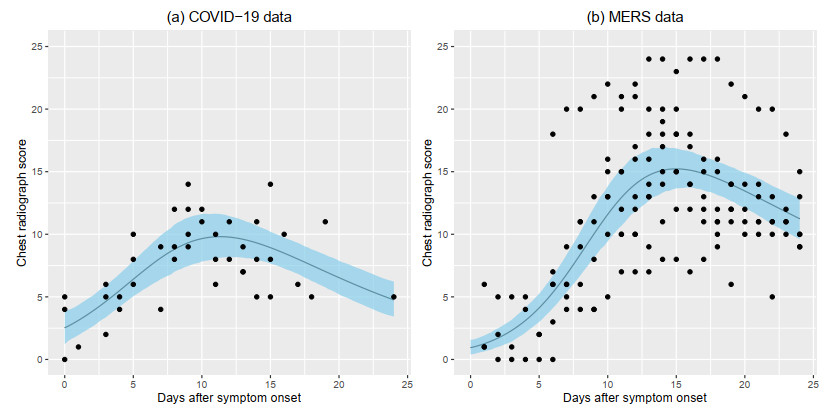









 DownLoad:
DownLoad:
